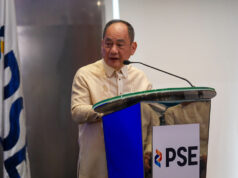Peso nears P54:$1 level on trade tensions, data
THE PESO weakened against the dollar on Tuesday as it inched closer to the P54 level amid continued cautiousness over trade tensions abroad fuelled by a wider local trade deficit in July.
The local unit closed Tuesday’s session at P53.94 versus the greenback, six centavos weaker than the P53.88-per-dollar finish on Monday. This is a fresh low for the peso in nearly 13 years or since it closed at P53.985 per dollar on Dec. 7, 2005.
The peso opened the session weaker at P53.94 versus the dollar, sinking to an intraday low of P53.97. Its best showing was at P53.87 per US unit.
Dollars traded slipped to $434.1 million from the $434.9 million that exchanged hands the previous day.
UnionBank of the Philippines chief economist Ruben Carlo O. Asuncion said the peso slipped further as the “trend is still toward weakness.”
“There is still lingering cautiousness on the escalation of US-China trade war,” Mr. Asuncion said in a text message.
China said it will respond if the United States takes new steps on trade as US President Donald J. Trump said he is ready to slap $267 billion in fresh tariffs on Chinese goods on top of the $200 billion to be implemented soon.
“The trade deficit also did not help to shore up the peso,” Mr. Asuncion added.
The country’s balance of trade in goods stood at a $3.55-billion deficit in July as imports accelerated while exports grew relatively flat.
Exports grew 0.3% to $5.85 billion in July, slower than the 2.8% growth in June as well as the 21.9% in July the previous year.
On the other hand, the country’s import bill increased 31.6% to $9.4 billion during the month, faster than the 24.2% the previous month while reversing the 0.3% decline in July 2017.
“Domestic demand continues to drive strong import growth which has not been matched by exports,” Nicholas Antonio T. Mapa, senior economist at ING N.V. Manila branch, said in an e-mail.
He added that the weak peso contributed to the weak trade performance, noting that the recent strong rhetoric from the Bangko Sentral ng Pilipinas (BSP) in response to elevated inflation and weakening local unit “could help stem the currency’s weakness and prevent the trade gap from widening further.”
Last Friday, BSP Governor Nestor A. Espenilla, Jr. said the central bank will take “strong immediate action” to address threats to price increase and inflation expectations.
For Wednesday, Mr. Asuncion expects the peso to move between P53.75 and P53.95, while a foreign currency trader gave a P53.80-P54 range.
PESO A VICTIM OF EM ROUT
Meanwhile, the Department of Finance (DoF) Tuesday, September 11, sought to dispel worries over the depreciation of the peso, which is among the victims of the emerging markets rout over the Turkey crisis, saying that macroeconomic policies are best indicators of resiliency.
“The Philippine peso has been moving in tandem with Asian currencies amid severe exchange rate volatility spawned by the global trade war, the Turkey-Argentina crisis and the Fed[eral Reserve] monetary normalization,” the DoF said in an economic bulletin on Tuesday.
“Maintaining good macroeconomic policies, through manageable fiscal and BoP (balance of payments) balances, and adopting economic reforms through tax reforms and still the best way to sustain growth and investment and, at the same time, steel the economy from external economic shocks,” the DoF said.
As of the first half, government revenues were above target by 8% due to the Tax Reform for Acceleration and Inclusion law as well as improved tax administration.
The peso fell to its lowest level in nearly 13 years last week, nearing the P54-a-dollar mark.
Following the local currency is the Chinese yuan, down 4.97%; the Korean won, down 4.46%; and Taiwan dollar, which lost 3.46%.
The DoF said the economies that saw their currencies depreciate the most saw the fastest growth rates among 12 emerging markets as of the first semester, with India at 8.2%, the Philippines at 6.3% and Indonesia at 5.2%.
“Since July 31 when emerging markets were the target of adverse hot money movements as contagion spread from problems in Turkey and Argentina, the Philippine peso depreciated by 0.82%, ranking 5th among 8 Asian countries whose currencies depreciated,” the DoF said.
According to the DoF, the Philippine peso depreciated by 7.39% since the start of the year, the third worst among 12 currencies of the fastest-growing Asian countries, behind the Indian rupee’s and Indonesian rupiah’s decline of 11.7% and 9%, respectively. — KANV and EJCT



